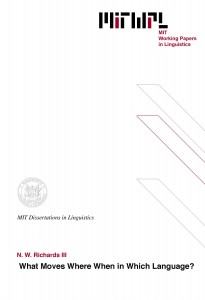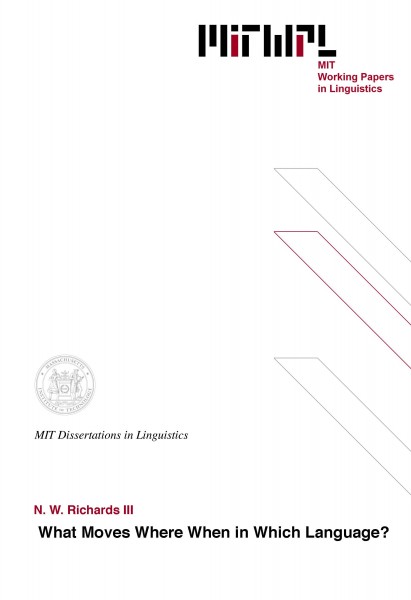What Moves Where When in Which Language?
N. W. Richards III, 1997
Much work in syntax has used the properties of wh-movement as a probe into the nature of the derivation. One perennial issue is the nature of wh-in-situ. Is wh-in-situ related to its scopal position by an operation like movement or by an entirely different process? If wh-in-situ does undergo invisible movement, why is the movement invisible? If we assume a derivational model, what is the relation between overt and covert movement in the derivation?
In this thesis I will investigate the properties of multiple-wh questions in a number of languages (particularly Bulgarian, Serbo-Croatian, Chinese and Japanese), in an attempt to find evidence for a particular answer to these questions. I will argue that the classic model assumed by the Extended Standard Theory is essentially correct; there is covert movement, and all covert movement follows all overt movement in the derivation (and is therefore invisible because it takes place after the point in the derivation at which the representation is interpreted by the phonological component).
One crucial aspect of the argument will involve investigation of the nature of additional-wh effects. I will claim that additional wh-effects only appear when certain structural and derivational conditions on the relation between the wh-movment involved are met, and additional-wh effects can therefore be used to determine which wh-movement operations precede which others.
Chapter 1 is an overview of some competing claims about the architecture of the grammar, and a discussion of the nature of evidence that might help us to choose among these claims. In Chapter 2 I discuss the distribution of wh-island effects in a number of languages, arguing that the overt/covert distinction is in fact irrelevant to the distribution of wh-islands. Chapter 3 is a discussion of the nature of Superiority effects in several languages. In Chapter 4 I investigate the nature of feature strength and develop a version of Procrastinate which is empirically distinct in several desirable ways from that developed by Chomsky (1993). Finally, Chapter 5 discusses additional-wh effects in some detail.
Thesis supervisor: David Pesetsky
Title: Professor of Linguistics
Table of Contents
Chapter 1 Introduction 13
1 Proposals 14
1.1 "T Model" 14
1.2 No covert movement 16
1.3 Single output syntax 16
1.4 Invisible overt movement 17
1.5 Theoretical summary 18
2 Assumptions 19
Chapter 2 Subjacency Forever 23
1 Problems: levels and taxes 23
2 CP-absorption and IP-absorption 27
3 Diagnostics for CP- and IP-absorption 29
3.1 Wh-islands 29
3.2 Scrambling 29
3.3 Superiority 31
3.4 Weak crossover 34
3.5 Wh-movement and QR 36
3.6 Interacting wh-dependencies 39
4 "Heterogeneous Movement" languages: German and English 46
5 Interlude: Hungarian 49
6 Conclusion 52
Chapter 3 Featural Cyclicity and the Ordering of Multiple Specifiers 55
1 Multiple wh-movement 62
2 Multiple A-specifiers 78
2.1 Idiom chunks 79
2.2 Quantifier scope 81
2.3 Scrambling generally 83
3 Object shift 90
4 Spec NegP 99
5 Cliticization 102
6 Freedom of ordering 103
6.1 Morphological effects on syntax: clitic ordering 106
6.2 Syntactic effects on syntax: Bulgarian wh-words 108
7 Shortest move 111
8 Equidistance 115
9 Conclusion 119
Chapter 4 Grappling with the Ineffable 121
1 Movement through a "weak" position 127
1.1 French participles 127
1.2 Object shift in mainland Scandinavian 129
1.3 V-to-I in mainland Scandinavian 131
1.4 Japanese wh-movement 132
1.5 Tagalog v. Chamorro 134
1.6 Agreement in Mohawk, Chichewa, and Irish 138
1.6.1 Mohawk 138
1.6.2 Chichewa 142
1.6.3 Irish 145
1.7 Derived object condition 148
1.8 Bulgarian vs. Serbo-Croatian 152
1.9 Conclusions 154
2 Destroying the evidence: ellipsis 162
2.1 (Pseudo)gapping 162
2.2 Multiple sluicing 162
2.3 Conclusions 168
3 "Bottom-heavy" chains 169
3.1 Japanese 170
3.2 Malay 173
4 An embarrassment of riches: movement to two strong features 176
4.1 "Weakening" the subject position 177
4.1.1 Anti-anti-agreement 184
4.1.1.1 Morphological anti-anti-agreement 184
4.1.1.2 Anti-anti-agreement and anaphora 187
4.1.1.3 Person-animacy hierarchies and
anti-agreement 189
4.1.2 Anti-agreement and ergativity 192
4.1.3 Interlude: Chamorro "um- 198
4.1.4 Anti-object-agreement 202
4.2 Subject-complementizer interactions 202
4.3 Improper movement, and proper improper movement 211
4.4 Japanese subject scrambling 218
4.5 Conclusion and expansions 222
5 Overall conclusions 225
Chapter 5 The Principle of Minimal Compliance 229
1 Introduction 229
2 Applications 232
2.1 Reflexivity 233
2.2 Weak crossover 235
2.3 VP-ellipsis 236
2.4 that-trace effects 237
2.5 Subjacency, CED 239
2.5.1 Dependencies 241
2.5.2 Links; connectedness 244
2.5.3 Interlude: Subjacency/CED vs. connectedness 249
2.6 Attractors and islands 254
2.6.1 Islands 255
2.6.1.1 Additional-wh effects in Bulgarian and
Japanese 255
2.6.1.2 Inside jobs; additional additional-wh effects 266
2.6.2 Attractors 274
2.6.2.1 Superiority 276
2.6.2.1.1 Bulgarian 280
2.6.2.1.2 Japanese 281
2.6.2.2 Path containment condition 296
2.6.2.2.1 The PCC in other languages 298
2.6.2.2.2 Volvo-sentences 322
3 Some possible further expansions 329
3.1 Stylistic fronting 329
3.2 Holmberg"s generlization 332
3.3 Lower-wh effects 333
4 Is the PMC recursive? 337
4.1 Path Containment Condition 337
4.2 that-trace effects 339
4.3 Parasitic gaps 341
5 Conclusion 342
Chapter 6 Conclusion 343

